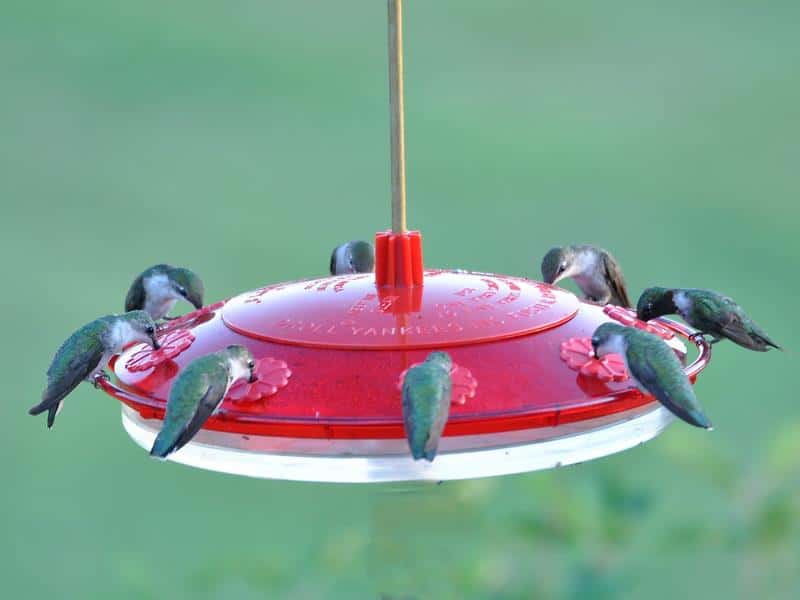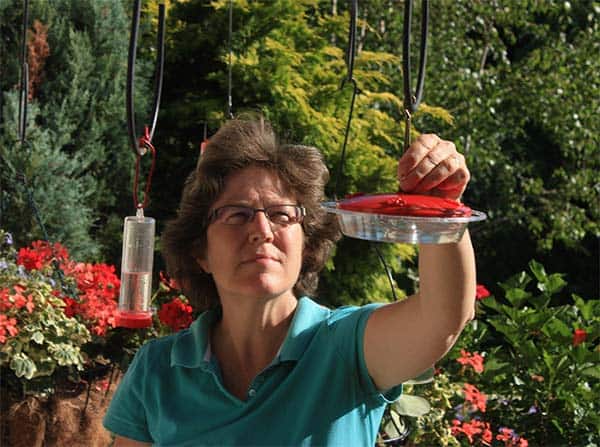There are a few things to keep in mind when placing your feeders. First of all, the feeders need to be where the birds can find them—near flowering plants is an ideal starting point. Secondly, the feeders need to be where you can see them, enjoy them, and get easy access for filling and cleaning. Thirdly, the feeders should be out of direct sunlight to slow the fermentation/spoilage process. Lastly, once the bird are tuned into your feeders, you can move them in short steps, to a more advantageous position.
Hummingbirds remember a reliable food source—even from year to year. Ask any veteran hummer host and they will be happy to tell you how their male hummingbird returns every spring and hovers in the exact spot where the feeder was last summer.
How often should I clean my feeders?
That’s like asking: “How often should I shower or brush my teeth?” The answer is, as often as necessary. But there’s no such thing as cleaning your feeders (or brushing your teeth) too much. In areas with daily summer temperatures above about 75°F, feeders should be cleaned every two to three days.
If your region has hotter ambient temperatures or your feeders get a lot of direct sunlight, clean them more frequently. Warm soapy water with a bit of gunk-scrubbing should do the trick. Some folks prefer to use white vinegar.
When should I put up (or take down) my feeder?
This answer depends upon where you live. Some regions of North America host hummingbirds all year long, so the answer for them is put your feeder up now and never take it down (except to refill and clean it of course!).
This question is at least partially motivated by the concern that leaving a feeder up will prevent hummingbirds from migrating in the fall. This is a myth. Hummingbirds (and all migratory birds) have an internal “clock” that tells them when to migrate. No healthy hummingbird would ever stick around just because you’ve left your feeder up in the fall.
However, late migrants, young inexperienced birds of the year, and hummers that are not completely healthy may be helped by the presence of your feeder, especially in areas where blooming flowers are scarce in fall and early winter.
Here in Ohio we put our first hummer feeder up right around April 15 because our spring arrivals records show that our first male ruby-throated hummingbird usually shows up around this date each year. For hummingbirds, as with other migratory songbird species, males return first each spring to establish territories and find reliable foraging spots.
Having your feeder and plenty of blooming flowers already in place when the first males return will enhance your chances of hosting hummingbirds throughout the spring and summer. We use hanging baskets of flowering plants to attract the hummers in years when our spring gardens are not yet in bloom.
How Important Are Feeders?
Hummingbird feeders are not vital to the survival of our native hummingbird species. At best they are an additional food source—after nectar-producing flowers—for hummingbirds. Nectar-producing flowering plants and flying insects are always going to be the most important food sources for hummingbirds. The one possible exception would be during periods of bad weather.
A late spring or early fall snow can cover flowering plants and stop insect activity. Or when a vagrant hummingbird shows up in winter at a nectar feeder. In such cases a clean feeder filled with fresh nectar can make all the difference for a bird’s survival.
As feeding and gardening for hummers has grown in popularity, more and more vagrant hummingbirds are being found in the East, Southeast, and in the gulf coast states. Each winter there are reports of western hummingbirds of several species spending the winter in places where they should not be. While you might be tempted to call these birds “lost,” in fact they are merely players in nature’s grand scheme of survival.
If their internal compass directs them to migrate east in the fall instead of south, and they survive the winter in, say, Huntington, West Virginia, and return to breed the following spring in the West, their offspring may possess the same internal navigation differences. Over time, this is how species expand their range, through trial and error and survival of the fittest.
There are hummingbird researchers who feel that the increasing numbers of over-wintering rufous hummingbirds in the eastern half of the United States are a direct result of the increase presence of hummingbird feeders and hardy blooming plants in human-altered landscapes. It’s an interesting phenomenon to ponder.




